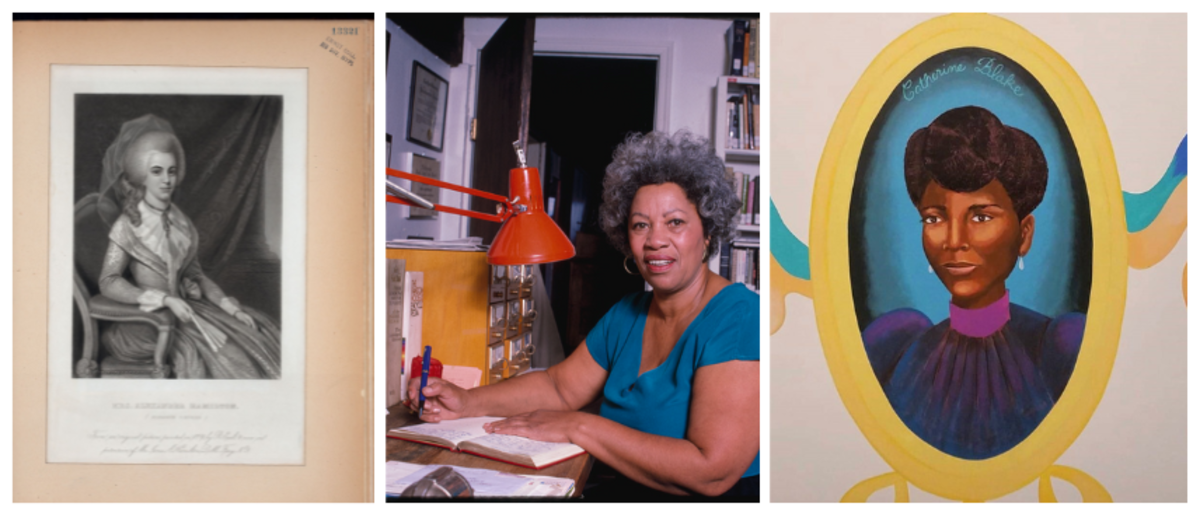
Celebrate Women's History Month! Ahead of International Women's Day on March 8, dive into the stories, lives, and legacies of 9 influential women who made their mark on Albany County and beyond.
1. Toni Morrison
The first Black woman to win the Nobel Prize in Literature, Toni Morrison is considered one of the greatest contemporary American novelists. Her influential works including Beloved, Sula, Song of Soloman, and The Bluest Eye, showcase her groundbreaking literary style. Focused on the Black experience in America, her works paved the way for authors from marginalized communities to share their stories.
Morrison left her mark in the capital city, she taught at UAlbany from 1984 to 1988 as the first Schweitzer Professor of Humanities. During this time, she published her Pulitzer-prize winning novel, Beloved. She also premiered her first play, Dreaming Emmet in Albany at the Capital Repertory Theatre. The play was co-sponsored by the New York State Writers Institute.
2. Catherine Blake
Catherine Blake left a lasting legacy in Albany. Widowed by Adam Blake Jr. in 1881, Catherine Blake surprised the public by becoming owner of the landmark Kenmore Hotel in downtown Albany for 7 years. Adam Blake Jr. was known as one of the most successful entrepreneurs of the 19th century. The adopted son of Adam Blake Sr. who was freed from slavery in 1811, Adam Blake Jr. made his way to the top of Albany's elite, owning and operating the breathtaking hotel and many other businesses in the area.
Following Blake's death, it was expected Catherine would sell the hotel, but an entrepreneur in her own right, she expanded the property before selling it for a massive profit once the lease was up. Many businessmen were desirous of the Kenmore property while it was under Catherine's name. This included Hiram Rockwell, a man who obtained the lease to a property at the front entrance of the Kenmore. The property was originally built for Adam Blake Jr. Once Catherine learned of this shady acquisition, she added two new buildings to the Kenmore property, changed the front entrance, and redirected customers to the "new Kenmore." At the time, she was one of the wealthiest women in Albany.
The Kenmore still stands today, operating as an apartment building, ballroom, and special event venue. The building also houses The Blake Annex, a co-working space named for the couple's legacy.
3. Harriet Myers
In the mid-1850's Stephen and Harriet Myers opened their home as a stop on the Underground Railroad, offering refuge for individuals escaping enslavement. Harriet was a leading figure, welcoming and caring for freedom seekers who came to her home. She maintained operations while her husband was away for work, advocated for women's rights, and secured assistance from other abolitionists to help those who sought refuge during times she had less money to give.
The Stephen and Harriet Myers residence still stands at 194 Livingston Avenue in Albany today. It operates as the Underground Railroad Education Center, a museum that preserves the couple's story and teaches on the Underground Railroad and Black Abolitionist history.
4. Lydia Mott
Lydia Mott was a leading figure of early women's suffrage and abolitionist movements in Albany. A lifelong friend of Susan B. Anthony, Mott would host Anthony at her townhouse on Columbia Street. Mott organized local lobbying efforts and conventions, working alongside other notable suffragists including Elizabeth Cady Stanton and Lucretia Mott. Lydia and her sister, Abigail, played active roles along the Underground Railroad in the area. The sisters housed, hid, and helped those escaping enslavement. Lydia Mott played a role in larger abolitionist efforts outside of the capital area, she served as vice-president of the American Anti-Slavery Society and her name appeared in national headlines alongside notable abolitionists like Frederick Douglass.
5. - 9. The Schuyler Sisters
The Schuyler sisters have become well known figures in America's history following Broadway's Hamilton but there are many parts of their story that couldn't make it into the musical.
The Schuyler sisters were born and raised in Albany. Their family home, where Alexander Hamilton and Elizabeth Schuyler were wed, still stands today operating as the Schuyler Mansion State Historic Site. There were five Schuyler sisters in total, Angelica, Elizabeth, Margaret ("Peggy"), Cornelia, and Catharine.
The sisters sat front-row to the founding of the nation. Their father, Philip Schuyler, was a revolutionary war general and senator of New York State during the nation's early years. Angelica and Elizabeth were socialites, friends of many revolutionary leaders including Thomas Jefferson, Marquis de Lafayette and Ben Franklin. Following Alexander Hamilton's death, Elizabeth worked to preserve her husband's legacy. She also founded New York's first private orphanage, the Orphan Asylum Society, and opened the first school in NYC's Washington Heights. Margaret married Stephen Van Rensselaer III, founder of Rensselaer Polytechnic Insitute in Troy.
Learn more about all five Schuyler sisters during a Women of Schuyler Mansion Focus Tour at the Schuyler Mansion throughout March 2025.
Read More
March is Women's History Month! To celebrate, dive into the life and legacy of women who left their
This International Women's Day we're showcasing six, history-making female athletes who have roots








